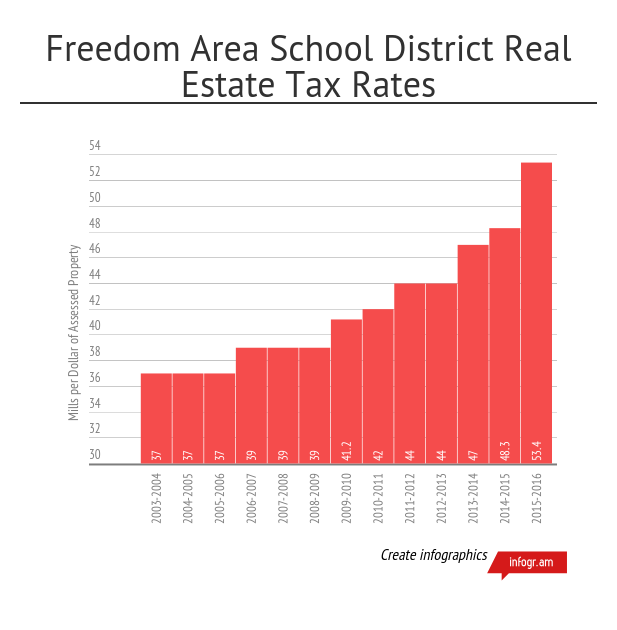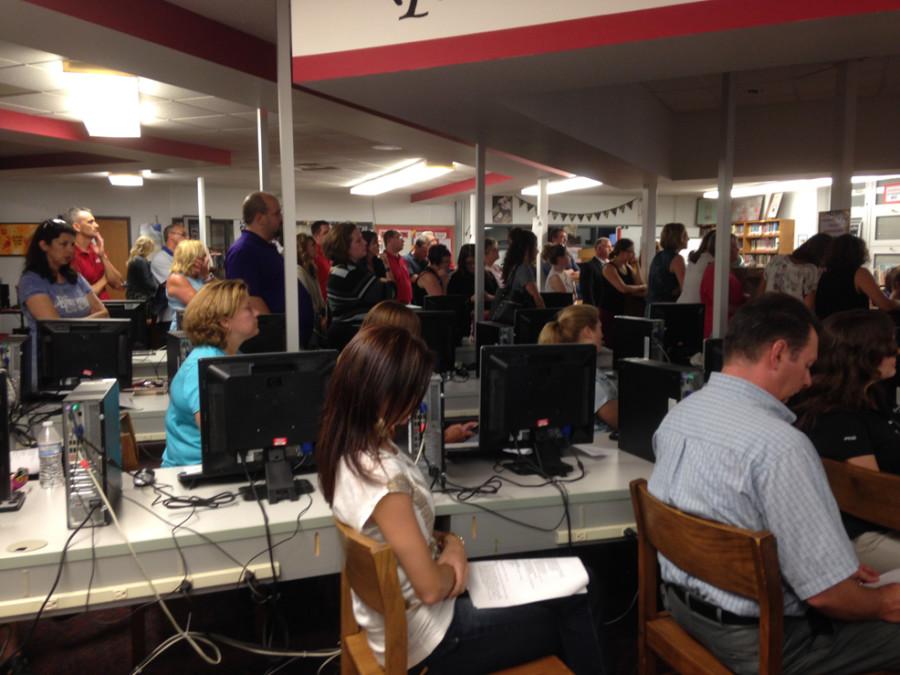‘Students are the center of the decision-making process’ ideal challenged
Teacher, community concerns lead to large crowd at School Board meeting
FASD teachers and community members fill the middle school library for the June 18 school board meeting.
On June 18, FASD parents, community members and more than 50 teachers filled the middle school library for the latest School Board meeting to voice their concerns about the District’s enrollment decline, teacher furloughs, student healthcare and tax increases.
Emotions ran high throughout the four-hour meeting during the floor time of its many public speakers, as the audience applauded after every agreeable statement said. The strongest reaction of the meeting came after School Board member Jennifer Sayre’s motion to approve the elementary program curtailment within the “Superintendent’s Report” failed to receive a second.
“During our work session, it was discussed by Dr. Fuller and the Board to take into consideration that ‘Administration will continue to monitor enrollments and make adjustments to elementary classes as student enrollment dictates.’ That piece, when added, received a second to Mrs. [Lori] Pail’s motion,” School Board Secretary Lorraine Rocco said.
When the ‘Education” items on the agenda were up for approval, School Board member Dawn Greene motioned to approve with the exception of item “M,” which consisted of nine transfers that were dependent on the elementary curtailment decision. After reaching the end of the agenda, the School Board went into executive session to discuss athletics and personnel matters. After more than an hour, the community was invited back into the library, where another vote was held on a teacher demotion and subsequent transfers.
The measure passed with a 6-1 vote, approving the demotion of high school English teacher, Blaire Lasko, from full time to half time, as well as the transfer of eight other teachers and instructional coaches district-wide. High school special education teacher, Danielle Barr, will move from full time to half time in special education to teach the half-time English course load created by Lasko’s demotion. DJ Sharpless, the only School Board member to vote against the measure, was unable to be reached at press time.
According to District policy, in the event of a furlough, the “checkerboard” model is employed to minimize staff cuts regardless of the number of moves it takes to fill other openings as long as each teacher ends up in an area for which he or she is certified.
“Because our teachers with the least amount of seniority were at the high school, that’s where the furlough ended up,” Superintendent Jeffrey Fuller said. “We start with the least senior teacher and move people around until we get to the position that we need to open.”
According to the District, the reason for the curtailments and furloughs is a district-wide decline in enrollment. For the 2015-2016 school year, enrollment for K-4 is currently projected to be 499 students, which is a 44-student decline from the 2014-2015 school year. The District’s total enrollment has also declined by 178 students, or 11 percent of the student population, in the past five school years.
Over the past 10 years, the School District has lost 10 teaching positions through attrition, not including the furloughs from the end of the 2014-2015 school year. Because attrition helped the District endure its declining enrollment, historically, some believe that building consolidation is a reason for the furloughs.
“The teachers have been told all along by Dr. Fuller that no one was going to lose their job because of consolidation,” President of the Freedom Area Education Association and high school Math Teacher, Ed Shephard said. “Now that we are furloughing teachers and not replacing those who are leaving for retirements or to pursue other opportunities, we are being told that it’s because of declining enrollment—not consolidation. The reality is that we have already been losing teachers due to declining enrollment.”
Another concern had to do with the change in elementary class sizes. The average expected class size for grades K-4 will be between 20.2-24 students per classroom. There are four projected classes for kindergarten and third grade and five classes for first, second and fourth grades. Kindergarten, first and fourth grade classrooms will have a smaller average class size, and second and third grade classrooms will have a larger average class size in the 2015-2016 school year.
One of the concerns mentioned at the meeting regarding increased class size is the number of kindergarten students who will require more attention while in the classroom. According to elementary teacher Erica Davids, several incoming students need early intervention or speech IEPs, aren’t toilet-trained yet or still need to be screened and meet with the school.
Mrs. Stacie Scheel, a District parent, also gave the perspective that her children don’t have any learning disabilities or health issues that infer with their learning experience; however, as the teachers give more attention to the students who need it, the other students may not be able to get all of the academic help they need.
As of June 18, there are 84 students enrolled for the kindergarten class in the 2015-2016 school year, which is a 26-student decrease from the 110 students in the 2014-2015 school year. According to Shephard, District enrollment has a tendency to increase over the summer and after the registration deadline. If kindergarten enrollment does increase over the summer, the average of 21 students for each of the four classes will increase as well.
For third grade, specifically, the average class size will increase from 20.2 students per class and 101 students in five classes to 24 students per class and 96 students in four classes.
Students are introduced to the Pennsylvania System of School Assessment (PSSA) tests in third grade. In larger classes, preparation for these standardized tests may be hindered.
“It is critically important for the ultimate success of these students that we get them properly prepared for the first round of PSSA tests that are given in third grade. These students will have enough to learn when they are in fourth grade without having to worry about spending time being remediated on what they were not able to master when they were in third grade,” Shephard said.
“If enrollment increased by eight students in either kindergarten or third grade, we would reevaluate. We are committed to keeping class sizes manageable,” School Board Vice President Mary Ann Petcovic said.
Several elementary and middle school teachers expressed concern that there will not be enough room for all faculty and students if there was an increase in enrollment in the future. At Big Knob and Conway, there was a combined total of 25 classrooms and three special education classrooms. In the middle school, there are 45 classrooms in total, including 11 rooms for third and fourth grade students and an elementary art room.
According to Fuller, however, the new building will sufficiently house all enrolled students.
“There are enough classrooms for our projected needs and for additional classrooms if there is a significant change in enrollment,” Fuller said.
In the new building, there are 17 classrooms, a Head Start preschool classroom and an additional classroom that will be utilized for an additional kindergarten classroom if enrollment increases. The music, physical education and library classes for grades kindergarten through fourth grade will be in the new elementary building, meaning that third and fourth grade students will head to the new building for those classes.
Mrs. Bonnie Adams, FASD school nurse, spoke to the School Board about the number of nurse positions for the upcoming school year. One nurse, Mrs. Beth Calahan, resigned before the previous school year and two nurses, Mrs. Marjorie Anderson and Mrs. Donna Dunning, retired at the end of the 2014-2015 school year, leaving Adams as the only nurse left in the District.
According to the Public School Code of 1949, there must be at least one nurse for every 1,500 students. Projected enrollment for FASD’s 2015-2016 school year is 1,426 students.
At the meeting, it was believed that there would only be one nurse for the entire District. This concerned many FASD parents, especially those who have children with medical problems. In cases where seconds count, like allergic reactions or asthma attacks, the nurse would have needed to travel quickly to another building, and, as a result, valuable time is lost.
“All you need is one child to die, and that’s too many for me,” Adams said.
According to Fuller, there are plans to have one full-time nurse and two aides in the District. The main nurse’s office will be in the middle school and there will be a nurse’s station, where minor injuries will be treated and students stay when they are waiting for a parent, in the elementary school office.
“We plan to have staff available in each building at all times,” Fuller said.
At this time, plans for how the nurse and aides will be distributed throughout the District were not yet decided.
“I have to see everything,” Adams said. She plans to travel between the middle school and high school buildings in order to do state reports, check on student immunizations, give physicals and make sure students get medication.
The health aide positions are planned to be posted in the local newspaper to seek for a registered nurse (RN) or licensed practical nurse (LPN). It was requested that the positions would be advertised as RN-preferred.
Freedom community members should also expect a tax increase. The projected tax rate for Freedom is 53.4 per dollar of assessed property. Only Central Valley’s rate of 51.2 is expected to be lower. The rate will increase by 5.1 mills, combining the Act 1 Allowable Index of 1.26 with the Pennsylvania Department of Education’s approved exception for special education and retirement costs of 3.84; this millage increase is greater than the increases of the 2011-2014 tax rates combined.
“[The tax increase] equates to an increase of approximately $124 per year for the median homeowner in the District,” Fuller said.
 On May 14, the School Board approved the curtailment of the music program, which resulted in the furlough of Mrs. Hillary Frankenstein, a part-time music teacher. After the end of the school year, part-time High School Special Education Teacher, Mr. Jeffrey Griffith was subject to furlough as well. This marked the first time the School District has furloughed a teacher since the 1980s.
On May 14, the School Board approved the curtailment of the music program, which resulted in the furlough of Mrs. Hillary Frankenstein, a part-time music teacher. After the end of the school year, part-time High School Special Education Teacher, Mr. Jeffrey Griffith was subject to furlough as well. This marked the first time the School District has furloughed a teacher since the 1980s.
Many of those in attendance voiced their frustrations over the outcome of the meeting, especially in regards to the teacher demotion and transfer decision.
“I believe there is a major disconnect between the Board, the administration and the community. I left the meeting feeling that teachers and community comments went completely unheard. Teachers are our biggest and greatest investment, and they deserve to be treated as such,” parent Leslie Rizzi said.
“We want the community to know that we consider many issues in making our decisions. Students are always at the center of our decisions while we must also be fiscally responsible to our taxpayers,” Petcovic said.
The next School Board meeting will be held on August 13 at 7 p.m. in the middle school library.



